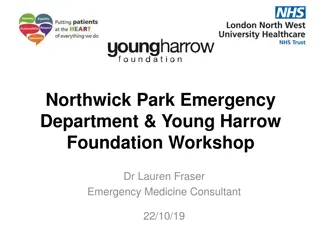
Comprehensive Strategies for Promoting Mental Health in Schools during COVID-19
Discover how pandemics impact learning in educational settings, the observed negatives and positives, and the importance of a whole-school approach to mental health and wellbeing in the context of COVID-19.
Download Presentation

Please find below an Image/Link to download the presentation.
The content on the website is provided AS IS for your information and personal use only. It may not be sold, licensed, or shared on other websites without obtaining consent from the author. If you encounter any issues during the download, it is possible that the publisher has removed the file from their server.
You are allowed to download the files provided on this website for personal or commercial use, subject to the condition that they are used lawfully. All files are the property of their respective owners.
The content on the website is provided AS IS for your information and personal use only. It may not be sold, licensed, or shared on other websites without obtaining consent from the author.
E N D
Presentation Transcript
Mentally healthy schools in the context of Covid- 19 Dr Daniel Ruddock, Senior Educational Psychologist & Emily Rayfield, Mental Health Improvement Officer HSL
How Do Pandemics Affect Learning In Schools/Colleges? Observed Negatives: Fear, stress, death, other losses, low mood, confusion and anger Changes in children s behaviour, attention/concentration Further inequalities and disparities Causing: Impact on relationships, decrease the flexibility of thinking and coping Diminishing sense of agency and therefore level of resilience Closing doors to learning Observed Positives: Compassion Community mindedness Concern Creating: Opportunities to open doors to new learning New relationships Increases in flexible thinking and coping More agency (a sense that you can make changes happen) (Co Space Study 2020) (Huremovic 2019) (Creswell et al 2020) (ONS 2020)
Schools/Colleges Are guiding lighthouses and offer safe harbours ...havens in a sea of uncertainty Provide predictability, consistency, availability, shared identity and the promise of change are engines of growth in time of turmoil Photo by Th ophile P ron on Unsplash
Whole School/College Approach to Mental Health and Wellbeing Curriculum, teaching and learning to promote resilience and support social and emotional learning An ethos and environment that Promotes respect And values diversity Targeted support and Appropriate referral Enabling student voice to influence decisions Leadership and management that supports and champions efforts to promote emotional health and wellbeing on, anger Staff development to support their own wellbeing and that of students Working with parents/carers Identify need and monitoring impact of interventions (Source Public Health England and Children and Young Peoples Mental Health Coalition, 2015)
How has your whole school approach been affected by COVID? PSHE and recovery are priorities for most schools Dramatic shift for school environment Curriculum, teaching and learning to promote resilience and support social and emotional learning An ethos and environment that Promotes respect And values diversity Reduced access to support for most pupils Lots of new but different opportunities for student involvement Targeted support and Appropriate referral Enabling student voice to influence decisions Leadership and management that supports and champions efforts to promote emotional health and wellbeing on, anger Staff development to support their own wellbeing and that of students Working with parents/carers More digital contact / less face-to-face Lots of staff are feeling more anxious Training needs may have shifted contact Identify need and monitoring impact of interventions Lack of data on how pupils and staff were affected (Source Public Health England and Children and Young Peoples Mental Health Coalition, 2015)
How has your whole school approach been affected by COVID? Key questions How are we embedding recovery in the curriculum? How are we making the school environment feel safe and welcoming? Curriculum, teaching and learning to promote resilience and support social and emotional learning An ethos and environment that Promotes respect And values diversity Are we expanding / adjusting targeted support to meet need? Are pupils being given space to share their experiences, feelings and feedback? Targeted support and Appropriate referral Enabling student voice to influence decisions Leadership and management that supports and champions efforts to promote emotional health and wellbeing on, anger Staff development to support their own wellbeing and that of students Working with parents/carers What are we doing to support and involve Do we know how staff are feeling? Is staff wellbeing being supported? parents? Identify need and monitoring impact of interventions How are we identifying need? (Beyond teacher observation) (Source Public Health England and Children and Young Peoples Mental Health Coalition, 2015)
Healthy Schools London Awards HSL Bronze HSL Silver HSL Gold AUDIT TOOL ACTION PLAN REPORT ON IMPACT For HSL website or log in enquiries Alison.Stafford@london.gov.uk www.healthyschoolslondon.org.uk For support with completing your awards RayfieldE@ealing.gov.uk https://www.egfl.org.uk/elp-services/health- improvement-schools/harrow-healthy-schools
HSL Silver Award: Mental Health Activities Ethos and environment Appoint a member of SLT as your Mental Health Lead Write/update and circulate your mental health policy Display posters around the school for pupils to know where to go for support Set up break-time buddies to help pupils who are upset or alone in the playground Staff development Set up a Mental Health Working Group for several members of staff to lead on mental health and wellbeing Carry out a staff wellbeing survey and develop an action plan Provide training for staff on bereavement / trauma Book training for Youth Mental Health First Aiders Identifying need Ensure staff are trained in identifying early warning signs for mental health needs Use sociograms to identify extra (and unnoticed) support needs for pupils Set up a worry box in each classroom Targeted support Set up a Nurture Group Contract the Educational Psychology Service for 1:1 and group counselling Curriculum, teaching and learning Introduce Zones of Regulation in all classrooms Introduce more PSHE lessons on mental health Explore growth mindset in all classrooms Working with parents Evaluate your current communication is this inclusive of language barriers / technology access etc. Provide information on what children are learning at school in terms of mental health Provide contact lists for local support services Student voice Include student reps in your mental health working group Use online voting to get feedback from all students





